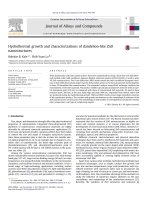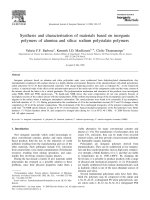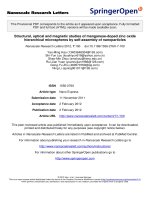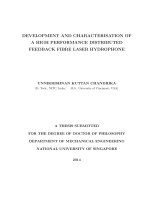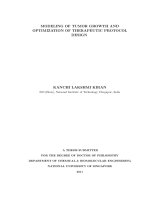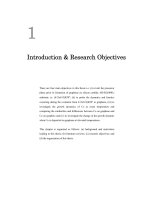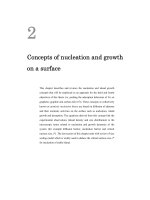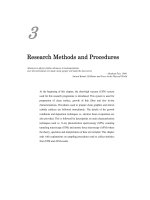Growth and characterisation of cobalt doped zinc oxide 1
Bạn đang xem bản rút gọn của tài liệu. Xem và tải ngay bản đầy đủ của tài liệu tại đây (192.95 KB, 35 trang )
Chapter 1 Introduction
1
CHAPTER 1
INTRODUCTION
1.1 Spintronics
In the last several decades, the number of transistors per unit area of an
integrated circuit (IC) has doubled approximately every 18 months, following a trend
known as Moore’s law.
1
If this trend continues, the Si-based technology will soon face
some physical limits which demand for alternative technologies. To this end, intensive
research work are being carried out, in both academia and industries, to look for
alternative technologies. Among them, spintronics, also known as spin electronics, has
the potential to create devices with superior performances due to the utilization of both
the charge and spin degree of freedoms of electrons.
2
Electrons possess two important properties: charge and spin. The ability to
generate, control and detect the motion of charges in either the free space (vacuum
tubes) or in solid state (Si-based electronic devices) forms the basis of modern
electronics. The controlled transition/recombination of electrons between different
energy levels leads to the absorption / generation of photons in the different range of the
electromagnetic spectrum, which forms the basis of optoelectronics (light-emitting
diodes and laser diodes). Compared to the charge and the photon, it is rather difficult to
generate, control and detect the spin of an electron. In fact, most of the spin-related
materials and devices to date still rely primarily on the spontaneous ordering of spins, in
the form of different types of magnetic materials. In information processing and
storage, charge-based devices are dominant. In information transmission, storage, and
display photonic devices are used. In contrast to the wide range of applications of
electronic and optoelectronic devices, the applications of spin-based materials and
Chapter 1 Introduction
2
devices, or spintronics, are still limited to information storage (e.g., hard disk drives).
3
From a long term perspective, spintronics has the potential of creating devices with less
or no moving charges, which may lead to devices and systems with faster response and
low power consumption.
4
It also promises a greater integration between the logic and
storage devices. The excellent temporal and spatial coherence of spins will also make
spintronic devices more suitable than their charge-based equivalents for quantum
information processing.
5
As illustrated in Fig.1-1, spintronics can be roughly divided
into the following categories: (i) metal-based, (ii) dilute magnetic semiconductor
(DMS)-based, (iii) pure semiconductor-based systems, (iv) hybrid devices and (v) other
technologies.
Figure 1-1 Schematic illustration of different areas of spintronics.
The metal-based spintronics has its origin in the giant magnetoresistance (GMR)
phenomenon, which has already been evolved into useful devices being used in hard
disk drives. Discovered by Fert
6
and Grünberg
7
, a typical GMR structure consists of two
ferromagnetic (FM) layers separated by a non-magnetic (NM) spacer (or the repetition
TiO
2
:Co
Oxide
-
Based
Si:Mn
Ge:Mn
IV
PbTe:Mn
PbSe:Mn
PbTe:Gd
Pb
IV
-
VI
GaAs:Mn
GaN:Mn
GaP:Mn
InAs:Mn
III
-
V
ZnSe:Mn
ZnTe:Cr
CdTe:Mn
CdSe:Mn
II
-
VI
Spintronics
Metal-
Based
Semiconductors
Dilute Magnetic
Semiconductors
Hybrid
devices
Others
ZnO:Co
ZnO:Mn
Chapter 1 Introduction
3
of this basic unit to form multilayers), as shown in Fig. 1-2. The resistivity of the
trilayer is strongly influenced by the relative orientation of the magnetization between
the two magnetic layers, due to dominantly spin-dependent interfacial scattering.
8
The
resistance of the trilayer is low when the magnetizations of the two layers are aligned in
parallel and is high when they are in anti-parallel configuration. The GMR is then
calculated as the ratio of resistance difference between the anti-parallel and parallel
configurations to the resistance in parallel configuration. Although the GMR is high in a
strongly coupled multilayer structure, it could not be used as it was in hard disk drives
because the external magnetic field that is required to switch the magnetizations is too
high. This has prompted IBM to invent a more practical structure for read sensors
which is called the spin-valve.
9
The state-of-the-art spin-valve consists of a dozen of thin layers; the heart of
which is a trilayer structure consisting of two ferromagnetic layers separated by a non-
magnetic spacer, which is usually copper. The primary difference between the original
GMR structure and spin-valve is that, in the latter, the thickness of the spacer is chosen
such that the coupling between the two ferromagnetic layers is minimized. This makes
it possible to use the spin-valve to detect rather weak magnetic field. The signal
detection principle is the same as that of the GMR structure, i.e., the resistance is high
when the magnetizations of the two layers are in opposite directions and low when they
are in the same direction. To have a linear response from the sensor, the angle between
the two magnetizations is normally set at 90
o
at zero-field with one of them “pinned” at
a direction perpendicular to the media surface through exchange-coupling with an
antiferromagnet and the other free to rotate in response to the fringe field of magnetic
transitions recorded on the magnetic media, also known as the free layer.
10
Chapter 1 Introduction
4
Figure 1-2 Schematic illustration of a GMR trilayer structure, with two ferromagnetic layers separated by
a non-magnetic spacer. The resistance is low when the magnetizations are parallel and high when they are
in anti-parallel configuration.
Low Resistance High Resistance
Ferromagnetic
layers
Spacer
Bit lines
Word lines
Figure 1-3 Schematic diagram of a MRAM cell.
There are two different forms of spin-valve sensors, depending on whether the
current flows in the plane of the stack of layers or perpendicular to them. The former is
called a current-in-plane, or CIP, spin-valve sensor and the latter a current-
perpendicular-to-plane, or CPP, sensor. So far, CIP is dominant, but CPP is expected to
play an important role in future terabit recording systems. An alternative of the CPP
spin-valve is the magnetic tunnel junction,
11,12
or MTJ, in which the current also flows
FM1
FM2
NM
FM1
FM2
NM
Parallel configuration
(Low resistance)
Anti-Parallel configuration
(High resistance)
Chapter 1 Introduction
5
perpendicular to the plane. The major difference between the CPP spin-valve and MTJ
is that the latter is composed of two ferromagnetic layers separated by an insulator
instead of a metal. Therefore, the electrical conduction in MTJ is based on quantum
mechanical tunneling. The recent rapid improvement of MTJ devices using crystalline
MgO barrier has paved the way for commercialization of MTJs in both hard disk drives
and magnetic random access memories (MRAMs) (see Fig. 1-3).
13
Although the metal-based spintronics has achieved unparalleled success in both
fundamental research and practical applications, the lack of capability in charge
modulation greatly limits its applications to information processing. Therefore, one of
the hottest issues in spintronics is how to create a stable source of spin-polarized
carriers in semiconductors, which allows not only the modulation of charges but also
manipulation of spins.
14-16
So far, several approaches have been proposed to solve this
problem,
17 - 20
including the injection of spins from a ferromagnetic metal into a
semiconductor via either a Schottky
21,22
or tunneling barrier,
23-26
generation of spin
polarized current using either a ferromagnetic semiconductor
27
or a non-magnetic
semiconductors based on spin-orbit interaction,
28
spin-dependent resonant tunneling,
29,30
Zeeman effect
31-33
and optical orientation.
34
In addition to the generation of spins, some
of the aforementioned effects such as spin-orbit interaction also provide a convenient
way to control the spins using an electrical field.
35
In spite of the significant progress
made recently in pure semiconductor or hybrid spintronic structures, the true era of
spintronics will probably only be materialized after room temperature magnetic
semiconductors become available.
Chapter 1 Introduction
6
1.2 Diluted magnetic semiconductors
1.2.1 Different types of DMSs
Magnetism and semiconducting properties are known to coexist in some
materials, such as europium chalcogenides
36 , 37
and ferrimagnetic or ferromagnetic
semiconducting spinels.
38
These materials have been extensively studied since 1960’s,
because of their peculiar properties resulting from the exchange interaction between
itinerant electrons and localized magnetic spins. These interactions lead to a rich
variety of optical and transport phenomena, which are strongly affected by the magnetic
field and temperature. However, the low Curie temperature, T
c
, and difficulties in
material preparation make this family of compounds less attractive from the application
point of view.
In addition to these “concentrated” magnetic semiconductors, there were also
intensive researches on diluted magnetic semiconductors which are obtained by doping
them with a few percent of magnetic ions.
39
Most initial work had been centered on II-
VI semiconductors (A,X)B where A = Zn, Cd, Hg, X = Fe, Mn, Co, Ni, Cr and B = S,
Se, Te, and in most cases the valence of group II cations is identical to that of most
magnetic transition metals. Although these materials are relatively easy to prepare,
most of them are random antiferromagnets or spin-glasses, which makes the II–VI DMS
unattractive for electronic applications. Nevertheless, the presence of sp-d exchange
interactions between d electrons of magnetic ions and electrons and holes of the host
semiconductor does make some of these materials very useful for magneto-optical
applications.
40
The ease of bandgap engineering as well as the preparation of
heterostructures in these materials also makes them excellent candidates for studying
spin-charge interaction and the corresponding dynamics in a variety of quantum
structures.
Chapter 1 Introduction
7
1.2.2 (Ga, Mn)As: A Model DMS System
Among all types of DMS materials studied so far, (Ga,Mn)As emerges as one of
the best understood model ferromagnet which exhibits not only the properties of a
metallic ferromagnet but also new functions such as electrical gating and strain
modulation of the magnetic properties.
41
The early work on III-V magnetic
semiconductors faced the difficulties of low solubility of transition metals in III-V
semiconductors, which made it difficult to achieve uniform doping of magnetic
impurities in these materials. The breakthrough came when attempts were made to
grow (In, Mn)As
42,43
and (Ga, Mn)As
44
using non-equilibrium molecular beam epitaxy
at low temperature, which allows the incorporation of Mn up to a few percent, with a
substantially suppressed formation of secondary phase. This has led to the discovery of
hole-induced ferromagnetic ordering in Mn-doped III-V semiconductors. In contrast to
Mn-doped II-VI DMS, where the Mn only contributes spins, when Mn is substituted for
gallium in GaAs or indium in InAs, it acts as both an acceptor, which provides holes
and also localized spins associated with d electrons of Mn
2+
ions.
38, 41
The former
mediates a ferromagnetic interaction among the localized spins of the opened d-shells of
the Mn atoms. The T
c
of (Ga, Mn)As is found to be dependent strongly on the hole
concentration, and the collective ferromagnetic behavior of the local spins requires a
minimum doping concentration of 2%. The T
c
was found to be almost a linear function
of the Mn composition up to about 5% beyond which, however, a further increase of
Mn concentration will cause a decreases of T
c
.
45
Annealing at low temperature was
found to greatly enhance the hole density and consequently the T
c
and saturation
magnetization (M
S
).
46-51
A T
c
up to 173 K has been obtained in annealed samples for a
Mn concentration of 6.4%.
52
It was also shown recently that the T
c
can be further
increased to about 250 K in heterostructures consisting of Mn δ-doped GaAs and p-type
Chapter 1 Introduction
8
AlGaAs layers by varying the growth sequence of the structures followed by low-
temperature annealing.
53
It is still not certain when and whether the T
c
can be pushed up
to above room temperature in the (Ga, Mn)As system.
54
In order to make DMS a real
technology, however, one needs to find DMS materials with a T
c
higher than room
temperature.
55-60
Theoretically, the mean-field Zener model predicts that DMSs with a T
C
above
room temperature are obtainable if the combination of host material, carrier
concentration, and magnetic impurity (type and density) is right.
61
In particular, if one
could introduce 5% of Mn and 3.5×10
20
cm
-3
of holes into wide-gap semiconductors,
such as GaN and ZnO, these materials should be ferromagnetic at room temperature. In
addition, the first-principles calculations also predict a rather stable ferromagnetism for
these materials.
62 , 63
Stimulated by these predications, intensive research has been
carried out to explore high T
C
diluted magnetic semiconductors, particularly oxide and
nitride based DMSs.
56-60
1.2.3 ZnO-based DMS Systems
Among all different types of materials that have been investigated, oxide-based
DMS systems have attracted special attention, in particular TiO
2
and ZnO based
materials because of their attractive properties and a wide range of applications. In this
proposal, the focus is on ZnO-based DMS. As mentioned above, theoretical studies
predicted that V, Cr, Fe, Co, or Ni doped ZnO is a half-metallic double-exchange
ferromagnet, whereas Ti or Cu doped ZnO remains paramagnetic; Mn doped ZnO is an
antiferromagnetic insulator which changes to a ferromagnet by additional doping of
holes, and ZnO doped with 5% Mn and 3.5×10
20
cm
-3
hole concentration has a T
c
above
room temperature.
61-63
It was also shown that electron doping stabilizes the
ferromagnetic ordering of Fe, Co, or Ni doped ZnO.
63
The first-principles spin-density
Chapter 1 Introduction
9
functional calculations by Lee and Chang predicted that heavy electron doping and high
Co concentration are required for obtaining ferromagnetism in cobalt doped zinc oxide
(ZnO:Co).
64
On the other hand, Spaldin argued theoretically that only hole doping
promotes ferromagnetism in both ZnO:Co and ZnO:Mn.
65
Till recently, Sluiter et al.
predicted that both hole doping and electron doping promote ferromagnetic ordering in
ZnO:Co and ZnO:Mn.
66
Hydrogen-mediated spin-spin interaction was also predicted to
be able to induce high temperature ferromagnetism in ZnO:Co.
72
Similar to theoretical work, experimental investigations to date have also
produced widely diverging results, ranging from non-ferromagnetic to ferromagnetic
with extrinsic origins to intrinsic ferromagnetism with various T
C
.
56,57,59
Ferromagnetism up to room temperature was first observed on 15 % Co-doped ZnO thin
film.
67
The average magnetic moment per Co atom was found to be 2 µ
B
. It was
suggested that there are three possible mechanisms responsible for the ferromagnetism:
(1) carrier-mediated ferromagnetic coupling between Co atoms; (2) weak magnetism of
CoO phase and (3) Co clusters. The mechanisms (2) and (3) were excluded from the
strength of the magnetic properties, Co composition dependence of lattice constant and
absence of Co cluster peaks in x-ray diffraction (XRD) peaks.
Since this first report, there have been over 200 journal papers published on
ZnO-based DMSs.
If the publications on ZnO-based DMS in the last 3 years
64,68-165
has been divided into four categories, based on their magnetic character: homogeneous
DMS, extrinsic ferromagnet, paramagnet, and others, the percentages of papers in the
four categories were 55%, 9%, 12% and 24%, respectively. This material still requires
much work before a consensus can be reached on its nature of magnetism. The large
disparity in experimental results is partially caused by the fact that the properties of
ZnO:Co are very sensitive to the structure and chemistry at the nanoscale regime, which
Chapter 1 Introduction
10
strongly depends on processing conditions. It is also caused by the lack of systematic
studies, particularly on the same sample. Most of the characterization techniques only
probe a certain portion or aspect of the sample in either the spatial or energy domain.
For samples with a nanoscale inhomogeneity, the results are meaningful only when the
relationships between the structures and properties at the nanometer scale are well
understood.
0
20
40
60
80
100
SEM
XRD
TEM
Raman
Neutron
EDX
RBS
XPS
NMR
Mossbauer
EPR
XAS
EPM
Optical
MCD
EELS
MR
Hall
AHE
R-T
DLTS
dI/dV
M-H
M-T
Susc - T
No. of publications
Figure 1-4 Number of papers versus characterization techniques for ZnO-based DMS.
RKKY
Magnetic
polaron
Paramagnetic Cluster
Secondary
phase
(a)
(b) (c) (d) (e)
RKKY
Magnetic
polaron
Paramagnetic Cluster
Secondary
phase
(a)
(b) (c) (d) (e)
Figure 1-5 Possible magnetic phases of ZnO-based DMSs.
Figure 1-4 summarizes the techniques that have been used to characterize ZnO-
based DMSs, which can be divided into five main groups: structural, chemical, optical,
electrical and magnetic characterization techniques. Similar statistics has been obtained
for TiO
2
-based DMS system. In order to understand how effective these techniques are
in characterizing the DMS, the different types of possible magnetism phases in
magnetically doped oxides is schematically shown in Figure 1-5. At very low doping
level, there is no or very little interaction among the magnetic dopants; therefore, the
system can be considered as either a paramagnet or weak magnet. In the latter case, a
Chapter 1 Introduction
11
small hysteresis might be originated from interaction between the local spin of d-
electrons and the crystal field of the host material. When the dopant concentration
further increases, other interactions such as Ruderman, Kittel, Kasuya, and Yosida
(RKKY), superexchange and double-exchange (in the case of mixed valence) may
become possible, and they can be either ferromagnetic or antiferromagnetic, depending
on the type and concentration of dopants and changed defects. Unlike (Ga, Mn)As and
(In, Mn)As, so far there has been no established report of carrier mediated or RKKY
ferromagnetism in ZnO-based DMSs. As the valence of transition metals in ZnO is
believed to be 2+, in order to introduce carriers into the material, one must rely on either
the doping of non-magnetic impurities or oxygen / zinc deficiency. These impurities
and dopants make the material highly defective which may easily lead to carrier
localization. For n-type ZnO, which is true in most cases, the localized electrons
surrounding the magnetic impurities will form so-called bound magnetic polarons (Fig.
1-5c).
39,54,166
The polarons increase in size when temperature decreases. When they
merge, ferromagnetic ordering may occur either locally or globally in the sample.
Depending on the growth techniques and conditions, most of the frequently reported
materials contain clusters of magnetic dopants or secondary phases (Fig. 1-5d and 1-5e).
The main difficulty in understanding the true mechanism of magnetic ordering in oxide-
based DMSs is that, in most cases, all these different phases are presence in a same
sample.
56,57,59,68-165
Therefore, it is almost impossible to identify the true mechanism by
using a combination of limited number of techniques shown in Fig. 1-4. For example,
x-ray diffraction is unable to differentiate cases (a)-(c) with cases (d) and (e) (Fig. 1-5)
unless the density and size of the clusters or secondary phases reach certain threshold
values. It will be difficult to detect the clusters and secondary phases by conventional
transmission electron microscopy (TEM) when they are either very small or too dilute.
Chapter 1 Introduction
12
The shape of the magnetization-field (M-H) or magnetization-temperature (M-T) curves
may tell some differences between cases (a), (b) and (c)-(e), but most practical cases fall
into categories (c)-(e). The observation of d-d transition in optical spectroscopy is often
used to prove that the transition metal dopants substitute the host cations. However,
most of the optical transmission spectroscopy has a low spatial resolution; moreover,
the observation of d-d transition does not necessarily mean that the observed magnetic
properties originated from carrier-mediated ferromagnetic alignment of substitutional
magnetic ions. The recently observed anomalous Hall effect (AHE), in principle, can
also originate from any one of the four categories (b)-(e). In the last two cases, the
AHE may arise from the fringe field of magnetic clusters.
167-169
The magnetic circular
dichroism (MCD) spectroscopy might be able to differentiate substitutional magnetic
ions from those of magnetic clusters; again MCD alone is unable to differientiate or
pinpoint any of the single phases due to limited spatial resolution.
170
In addition to chemical or structural inhomogeneity, magnetic inhomogeneity
also exists in DMSs due to the formation of bound magnetic polarons. Although it is
generally believed that the ferromagnetism below T
C
in (Ga,Mn)As is caused by hole-
mediated RKKY interaction, the real mechanism is still not well understood in
particular at the nanoscale regmine. The mechanism of magnetic interaction about the T
c
is even more complicated. The bound magnetic polaron model has been used to describe
how the ferromagnetic ordering occurs when the sample is cooled across the T
c
.
39,54,166
Due to defects and random distribution of magnetic dopants, carrier localization is
expected to happen at local potential minimum when the sample temperature is reduced.
The carrier localization is particularly enhanced in the insulating regime where impurity
band forms in the deep gap of the host semiconductor.
171
The interaction of magnetic
impurity and localized carriers leads to the formation of magnetic polarons. The size of
Chapter 1 Introduction
13
magnetic polaron increases with decreasing temperature and ferromagnetic ordering
takes place when the magnetic polarons merge at the T
c
. When the magnetic dopant
density increases, the direct Mn-Mn antiferromagnetic interaction will gradually
become dominant, which eventually reduces the T
c
to zero. The magnetic polaron
picture is believed to be also true for other types of DMSs, in particular, those in which
carrier mediated ferromagnetism has not been confirmed such as Co-doped ZnO. In
addition to the aforementioned study of structural and chemical inhomogeneity, the
transport technique should also be very useful in probing the formation and interaction
of magnetic polarons in DMSs.
Compared to structural, chemical, optical and magnetic characterization,
detailed study of electrical transport properties is still lacking. Electrical transport study
is a powerful technique for characterizing spintronic materials, in particular, when the
samples are inhomogeneous in nature. Inhomogeneity and disorder exist virtually in all
types of materials. Most of the DMS can be considered in this regime because of the
presence of precipitates of magnetic dopants, secondary phases, defects and random
distribution of magnetic impurities. Inhomogeneity and disorder affect the transport and
response of the system to external excitations such as electrical and magnetic field, light
and thermal excitations. In the simplest transport measurement, one measures either the
current-voltage (I-V) or differential conductance versus voltage (dI/dV – V) curve using
a four-probe technique. In the case that the inhomogeneous region is much smaller than
the specimen size, no noticeable effect originated from inhomogeneity will be observed
in both the I-V and dI-dV curves unless the density of inhomogeneity exceeds a certain
percolation threshold. However, the situation will change when the samples are
fabricated into one-dimensional nanowires. In this case, due to the geometrical
confinement of current path, most of the electrons will have to encounter the
Chapter 1 Introduction
14
inhomogeneous region before they could reach the other end of the sample. Depending
on the nature of electrical conduction in both the host matrix and inhomogeneous region,
one may observe I-V curves with different characteristics. In oxide-based DMS, one
may encounter the following different situations:
Table 1-1 Summary of transport properties in oxide-based DMS system.
Inhomogeneous region
Magnetic clusters
Ferromagnetic
semiconductor
Insulating
Magnetic tunnel
junctions / coulomb /
spin blockade
Ferromagnetic
semiconductor tunnel
junctions Host matrix
(semiconductor)
Conductive
Nano-Schottky
junctions
Nanoscale spin-injection
between DMS and
semiconductors
As all these cases will result in different dI/dV curves with an applied magnetic
field, the results with the data obtained can be correlated with results from other
characterization techniques so as to reveal the mechanism of magnetic ordering in ZnO-
based DMSs.
1.3 Motivation and Objectives of this Work
As discussed above, there is strong demand for DMS materials with T
C
higher
than room temperature for spintronic applications. Although room temperature oxide-
DMSs have been reported, recent studies have produced widely diverging results, in
Chapter 1 Introduction
15
magnetic properties, likely due to the different processing conditions used. In addition
to the high-sensitivity of magnetic properties to preparation techniques and conditions,
the rather chaotic situation is also caused by the lack of a commonly agreeable way to
determine if a DMS is intrinsic when a magnetic moment versus applied field curve
with a very small hysteresis is observed in a simple magnetometry measurement. The
common approach taken so far by most experimental work which supports the existence
of intrinsic ferromagnetism in ZnO:Co is as follows. First, the existence of
ferromagnetism is “confirmed” by either direct measurement using a magnetometer or
the combination of this with indirect measurements such as MCD and x-ray MCD.
Second, the presence of precipitates and other secondary phases is “excluded” by high-
resolution transmission electron microscopy (HRTEM) and x-ray diffraction
measurements. Third, substitution of Zn with Co into the host matrix is confirmed by
optical absorption, magneto-optical spectroscopy (including the confirmation of
coupling between band carriers with d electrons of the Co ions) or other valence
analysis techniques. The validity of this approach is only relevant if all the
measurements are performed on the same physical location of the same sample as well
as if the measured results are well correlated with each other. In the latter case, in
addition to magnetic and magneto-optical measurements, it is also of great importance
to perform systematic studies of electrical transport properties. Given the fact that it is
almost impossible to ensure that all the sample preparation techniques and conditions
are identical for experiments performed at different groups, researchers should at least
make efforts to conduct systematic studies using their own specific experimental setups.
In order to draw meaningful conclusions from the experiments, it is crucial that all
different types of characterizations should be carried out on same samples instead of
samples with similar chemical concentrations.
Chapter 1 Introduction
16
Based on this background, the main objectives of this work are to conduct a
systematic study of ZnO:Co thin films prepared by sputtering with Co composition
varying in a large range. Special attentions will be paid to ensure that a series of
characterization experiments can be performed on each of the series of samples studied.
Emphasis will be on finding out if there is any correlation between the results obtained
from different characterization techniques so as to reveal the real mechanism of
magnetism in ZnO:Co thin films.
1.4 Organization of the Thesis
After having provided a brief background of this research, an overview of the
work done so far on Co-doped ZnO is provided in Chapter 2. Mn doped ZnO and Co
doped TiO
2
are also briefly introduced in this chapter. Chapter 3 describes the growth
and characterization techniques used in this work, in which the focus is on those which
are more specific to this work. The structural and chemical analyses of the obtained
films are given in Chapter 4, while Chapters 5 and 6 describe the magnetic and
electrical transport properties, respectively. This work is summarized and some
suggestions for future work are also provided in Chapter 7.
References:
1
M. Quirk and J. Serda, Semiconductor manufacturing technology, (Upper Saddle
River, NJ: Prentice Hall, 2001).
2
S. A. Wolf, D. D. Awschalom, R. A. Buhrman, J. M. Daughton, S. Von Molnár, M. L.
Roukers, A. Y. Chtchelkanova, and D. M. Treger, “Spintronics: A spin-based
electronics vision for the future”, Science 294, 1488 (2001).
Chapter 1 Introduction
17
3
Y. H. Wu, “Nano-spintronics for data storage”, Encyclopedia of Nanoscience and
Nanotechnology, 7, 493 (2004).
4
D. D. Awschalom, M. E. Flatté, and N. Samarth, “Spintronics”, Scientific American,
286, 66 (2002).
5
R. Ramesh and N. A. Spaldin, “Multiferroics: progress and prospects in thin films”,
Nat. Mater. 6, 21 (2007).
6
M. N. Baibich, J. M. Broto, A. Fert, F. N. Van Dau, F. Petroff, P. Eitenne, G. Greuzet,
A. Friederich, and J. Chazelas, “Giant magnetoresistance of (001)Fe/(001)Cr magnetic
superlattices”, Phys. Rev. Lett. 61, 2472 (1988).
7
G. Binash, P. Grünberg, F. Saurenbach, and W. Zinn, “Enhanced magnetoresistance in
layered magnetic structures with antiferromagnetic interlayer exchange”, Phys. Rev. B
39, 4828 (1989).
8
S. S. P. Parkin, “Origin of enhanced magnetoresistance of magnetic multilayers: Spin-
dependent scattering from magnetic interface states”, Phys. Rev. Lett. 71, 1641 (1993).
9
B. Dieny, V. S. Speriosu, S. S. P. Parkin, B. A. Gurney, D. R. Wilhoit, and D. Mauri,
“Giant magnetoresistive in soft ferromagnetic multilayers”, Phys. Rev. B 43, 1297
(1991).
10
S. Parkin, J. Xin, C. Kaiser, A. Panchula, K. Roche, and M. Samant, “Magnetically
engineered spintronic sensors and memory”, Proc. IEEE 91, 661 (2003).
11
T. Miyazaki and N. Tezuka, “Giant magnetic tunneling effect in Fe/Al
2
O
3
/Fe
junction”, J. Magn. Magn. Mater. 139, L231 (1995).
12
J. S. Moodera, L. R. Kinder, T. M. Wong, and R. Meservey, “Large
magnetoresistance at room temperature in ferromagnetic thin film tunnel junctions”,
Phys. Rev. Lett. 74, 3273 (1995).
Chapter 1 Introduction
18
13
S. S. P. Parkin, C. Kaiser, A. Panchula, P. M. Rice, B. Hughes, M. Samant, and S. H.
Yang, “Giant tunneling magnetoresistance at room temperature with MgO (100) tunnel
barriers”, Nat. Mater. 3, 862 (2004).
14
H. Ohno, “Semiconductors - Toward functional spintronics”, Science 291, 840 (2001).
15
H. Ohno, “Special issue on Semiconductor Spintronics – Preface”, Semiconductor Sci.
and Technol. 17 (2002).
16
E. I. Rashba, “Spintronics: Sources and challenge”, J. Supercond. 15, 13 (2002).
17
A. Fert and H. Jaffres, “Conditions for efficient spin injection from a ferromagnetic
metal into a semiconductor”, Phys. Rev. B, 64, 184420 (2001).
18
H. J. Zhu, M. Ramsteiner, H. Kostial, M.Wassermeier, H. P. Schonherr, and K. H.
Ploog, “Room-temperature spin injection from Fe into GaAs”, Phys. Rev. Lett. 87,
16601 (2001).
19
D. L. Smith and R. N. Silver, “Electrical spin injection into semiconductors”, Phys.
Rev. B 64, 045323 (2001).
20
B. T. Jonker, Y. D. Park, B. R. Bennett, H. D. Cheong, G. Kioseoglou, and A. Petrou,
“Robust electrical spin injection into a semiconductor heterostructure”, Phys. Rev. B 62,
8180 (2000).
21
J. D. Albrecht and D. L. Smith, “Electron spin injection at a Schottky contact”, Phys.
Rev. B, 66, 113303 (2002).
22
G. Schmidt and L. W. Molenkamp, “Spin injection into semiconductors, physics and
experiments”, Semicond. Sci. Technol. 17, 310 (2002).
23
E. I. Rashba, “Theory of electrical spin injection: Tunnel contacts as a solution of the
conductivity mismatch problem”, Phys. Rev. B 62, R16267 (2000).
Chapter 1 Introduction
19
24
V. F. Motsnyi, J. De Boeck, J. Das, W. Van Roy, G. Borghs, E. Goovaerts, and V. I.
Safarov, “Electrical spin injection in a ferromagnet/tunnel barrier/semiconductor
heterostructure”, Appl. Phys. Lett. 81, 265 (2002).
25
A. T. Hanbicki, B. T. Jonker, G. Itskos, G. Kioseoglou, and A. Petrou, “Efficient
electrical spin injection from a magnetic metal/tunnel barrier contact into a
semiconductor”, Appl. Phys. Lett. 80, 1240 (2002).
26
X. Hao, J. S. Moodera, and R. Meservey, “Spin-filter effect of ferromagnetic
europium sulfide tunnel barriers”, Phys. Rev. B 42, 8235 (1990).
27
Y. Ohno, D. K. Young, B. Beschoten, F. Matsukura, H. Ohno, and D.D. Awschalom,
“Electrical spin injection in a ferromagnetic semiconductor heterostructure”, Nature 402,
790 (1999).
28
F. Zhai and H. Q. Xu, “Generation of spin polarization in two-terminal electron
waveguides by spin-orbit interaction and magnetic field modulations”, Phys. Rev. B 72,
085314 (2005).
29
Erasmo A. de Andrada e Silva and Giuseppe C. La Rocca, “Electron-spin polarization
by resonant tunneling”, Phys. Rev. B 59, R15583 (1999).
30
Z. Y. Lu, X. G. Zhang, and S. T. Pantelides, “Spin-dependent resonant tunneling
through quantum-well states in magnetic metallic thin films”, Phys. Rev. Lett. 94,
207210 (2005).
31
C. J. Egues, “Spin-dependent perpendicular magnetotransport through a tunable
ZnSe/Zn
1-x
Mn
x
Se heterostructure: A possible spin filter?”, Phys. Rev. Lett. 80, 4578
(1998).
32
Y. Guo, J. Q. Lu, B. L. Gu, and Y. Kawazoe, “Spinresonant splitting in magnetically
modulated semimagnetic semiconductor superlattices”, Phys. Rev. B 64, 155312 (2001).
Chapter 1 Introduction
20
33
R. Fiederling, M. Keim, G. Reuscher, W. Ossau, G. Schmidt, A. Waag, and L. W.
Molenkamp, “Injection and detection of a spinpolarized current in a light- emitting
diode”, Nature 402, 787 (1999).
34
F. Meier and B. P. Zakharchenya (Eds.), Optical Orientation, (North-Holland, New
York, 1984).
35
E. I. Rashba and Al. L. Efros, “Orbital mechanisms of electron-spin manipulation by
an electric field”, Phys. Rev. Lett. 91, 126405 (2003).
36
T. Kasuya and A. Yanase, “Anomalous transport phenomena in Eu-chalcogenide
alloys”, Rev. Mod. Phys. 40, 684 (1968).
37
S. Methfessel, F. Holtzberg, and T. McGuire, “Optical absorption and ferromagnetic
exchange in Eu chalcogenides”, IEEE Trans. Magn. 2, 305 (1966).
38
T. Dietl, “Ferromagnetic semiconductors”, Semicond. Sci. Technol. 17, 377 (2002).
39
J. K. Furdyna, “Diluted magnetic semiconductors”, J. Appl. Phys. 64, R29 (1988).
40
A. E. Turner, R. L. Gunshor, and S. Datta, “New class of materials for optical
isolators”, Appl. Opt. 22, 3152 (1983).
41
H. Ohno, “Making nonmagnetic semiconductors ferromagnetic, Science 281, 951
(1998).
42
H. Munekata, H. Ohno, S. Von Molnar, A. Segmüller, L. L. Chang, and L. Esaki,
“Diluted magnetic III-V semiconductors”, Phys. Rev. Lett. 63, 1849 (1989).
43
H. Ohno, H. Munekata, T. Penney, S. von Molnár, and L. L. Chang,
“Magnetotransport properties of p-type (In,Mn)As diluted magnetic III-V
semiconductors”, Phys. Rev. Lett. 68, 2664 (1992).
44
H. Ohno, A. Shen, F. Matsukura, A. Oiwa, A. Endo, S. Katsumoto, and Y. Iye,
“(Ga,Mn)As: A new diluted magnetic semiconductor based on GaAs”, Appl. Phys. Lett.
69, 363 (1996).
Chapter 1 Introduction
21
45
F. Matsukura, H. Ohno, A. Shen, and Y. Sugawara, “Transport properties and origin
of ferromagnetism in (Ga,Mn)As”, Phys. Rev. B 57, R2037 (1998).
46
T. Hayashi, Y. Hashimoto, S. Katsumoto, and Y. Iye, “Effect of low-temperature
annealing on transport and magnetism of diluted magnetic semiconductor (Ga, Mn)As”,
Appl. Phys. Lett. 78, 1691 (2001).
47
S. J. Potashnik, K. C. Ku, S. H. Chun, J. J. Berry, N. Samarth, and P. Schiffer,
“Effects of annealing time on defect-controlled ferromagnetism in Ga
1–x
Mn
x
As”, Appl.
Phys. Lett. 79, 1495 (2001).
48
K. W. Edmonds, K. Y. Wang, R. P. Campion, A. C. Neumann, N. R. S. Farley, B. L.
Gallagher, and C. T. Foxon, “High-Curie-temperature Ga
1–x
Mn
x
As obtained by
resistance-monitored annealing:, Appl. Phys. Lett. 81, 4991 (2002).
49
K. C. Ku, S. J. Potashnik, R. F. Wang, S. H. Chun, P. Schiffer, N. Samarth, M. J.
Seong, A. Mascarenhas, E. Johnston-Halperin, R. C. Myers, A. C. Gossard, and D. D.
Awschalom, “Highly enhanced Curie temperature in low-temperature annealed
[Ga,Mn]As epilayers”, Appl. Phys. Lett. 82, 2302 (2003).
50
K. W. Edmonds, P. Bogusawski, K. Y. Wang, R. P. Campion, S. N. Novikov, N. R. S.
Farley, B. L. Gallagher, C. T. Foxon, M. Sawicki, T. Dietl, M. B. Nardelli, and J.
Bernholc, “Mn interstitial diffusion in (Ga,Mn)As”, Phys. Rev. Lett. 92, 037201 (2004).
51
D. Chiba, K. Takamura, F. Matsukura, and H. Ohno, “Effect of low-temperature
annealing on (Ga,Mn)As trilayer structures”, Appl. Phys. Lett. 82, 3020 (2003).
52
K. Y. Wang, R. P. Campion, K. W. Edmonds, M. Sawicki, T. Dietl, C. T. Foxon, and
B. L. Gallagher, “Magnetism in (Ga,Mn)As thin films with T
C
Up To 173K”, AIP Conf.
Proc. 772, 333 (2005).
Chapter 1 Introduction
22
53
A. M. Nazmul, T. Amemiya, Y. Shuto, S. Sugahara, and M. Tanaka, “High
temperature ferromagnetism in GaAs-based heterostructures with Mn δ doping”, Phys.
Rev. Lett. 95, 017201 (2005).
54
A. H. MacDonald, P. Schiffer, and N. Samarth, “Ferromagnetic semiconductors:
moving beyond (Ga,Mn)As”, Nat. Mater. 4, 195 (2005).
55
H. Saito, V. Zayets, S. Yamagata, and K. Ando, “Room-temperature ferromagnetism
in a II−VI diluted magnetic semiconductor Zn
1-x
Cr
x
Te”, Phys. Rev. Lett. 90, 207202
(2003).
56
S. J. Pearton, W. H. Heo, M. Ivill, D. P. Norton, and T. Steiner, “Dilute magnetic
semiconducting oxides”, Semicond. Sci. Technol. 19, R59 (2004).
57
T. Fukumura, H. Toyosaki, and Y. Yamada, “Magnetic oxide semiconductors”,
Semicond. Sci. Technol. 20, S103 (2005).
58
S. J. Pearton, C. R. Abernathy, G. T. Thaler, R. M. Frazier, D. P. Norton, F. Ren, Y.
D. Park, J. M. Zavada, I. A. Buyanova, W. M. Chen, and A. F. Hebard, “Wide bandgap
GaN-based semiconductors for spintronics”, J. Phys.: Condens. Matter. 16, R209 (2004).
59
R. Janisch, P. Gopal, and N. A Spaldin, “Transition metal-doped TiO
2
and ZnO—
present status of the field”, J. Phys.: Condens. Matter 17, R657 (2005).
60
Y. Matsumoto, M. Murakami, T. Shono, T. Hasegawa, T. Fukumura, M. Kawasaki, P.
Ahmet, T. Chikyow, S. Y. Koshihara, and H. Koinuma, “Room-temperature
ferromagnetism in transparent transition metal-doped titanium dioxide”, Science 291,
854 (2001).
61
T. Dietl, H. Ohno, F. Matsukura, J. Cibert, and D. Ferrand, “Zener model description
of ferromagnetism in zinc-blende magnetic semiconductors”, Science 287, 1019 (2000).
62
K. Sato and H. K. Yoshida, “Material design for transparent ferromagnets with ZnO-
based magnetic semiconductors”, Jpn. J. Appl. Phys. 39, L555, (2000).
Chapter 1 Introduction
23
63
K. Sato and H. K. Yoshida, “Stabilization of ferromagnetic states by electron doping
in Fe-, Co- or Ni-Doped ZnO”, Jpn. J. Appl. Phys. 40, L334 (2001).
64
E. C. Lee and K. J. Chang, “Ferromagnetic versus antiferromagnetic interaction in
Co-doped ZnO”, Phys. Rev. B 69, 085205 (2004).
65
N. A. Spaldin, “Search for ferromagnetism in transition-metal-doped piezoelectric
ZnO”, Phys. Rev. B 69, 125201 (2004).
66
M. H. F. Sluiter, Y. Kawazoe, P. Sharma, A. Inoue, A. R. Raju, C. Rout, and U. V.
Waghmare, “First principles based design and experimental evidence for a ZnO-based
ferromagnet at room temperature”, Phys. Rev. Lett. 94, 187204 (2005).
67
K. Ueda, H. Tabata, and T. Kawai, “Magnetic and electric properties of transition-
metal-doped ZnO films”, Appl. Phys. Lett. 79, 988 (2001).
68
M. Bouloudenine, N. Viart, S. Colis, J. Kortus, and A. Dinia, “Antiferromagnetism in
bulk Zn
1–x
Co
x
O magnetic semiconductors prepared by the coprecipitation technique”,
Appl. Phys. Lett. 87, 052501 (2005).
69
J. Antony, S. Pendyala, A. Sharma, X. B. Chen, J. Morrison, L. Bergman, and Y.
Qiang, “Room temperature ferromagnetic and ultraviolet optical properties of Co-doped
ZnO nanocluster films”, J. Appl. Phys. 97, 10D307 (2005).
70
B. Martínez, F. Sandiumenge, Ll. Balcells, J. Fontcuberta, F. Sibieude, and C. Monty,
“Magnetic properties of Co-doped ZnO nanoparticles prepared by vaporization-
condensation in a solar reactor”, J. Appl. Phys. 97, 10D311 (2005).
71
A. Dinia, G. Schmerber, C. Mény, V. Pierron-Bohnes, and E. Beaurepaire, “Room-
temperature ferromagnetism in Zn
1–x
Co
x
O magnetic semiconductors prepared by
sputtering”, J. Appl. Phys. 97, 123908 (2005).
72
C. H. Park and D. J. Chadi, “Hydrogen-mediated spin-spin interaction in ZnCoO”,
Phys. Rev. Lett. 94, 127204 (2005).
Chapter 1 Introduction
24
73
K. R. Kittilstved, N. S. Norberg, and D. R. Gamelin, “Chemical manipulation of high-
T
C
ferromagnetism in ZnO diluted magnetic semiconductors”, Phys. Rev. Lett. 94,
147209 (2005).
74
B. Martínez, F. Sandiumenge, Ll. Balcells, J. Arbiol, F. Sibieude, and C. Monty,
“Role of the microstructure on the magnetic properties of Co-doped ZnO nanoparticles”,
Appl. Phys. Lett. 86, 103113 (2005).
75
J. S. Hong and R. Q. Wu, “Magnetic ordering and x-ray magnetic circular dichroism
of Co doped ZnO”, J. Appl. Phys. 97, 063911 (2005).
76
G. Lawes, A. S. Risbud, A. P. Ramirez, and Ram Seshadri, “Absence of
ferromagnetism in Co and Mn substituted polycrystalline ZnO”, Phys. Rev. B 71,
045201 (2005).
77
W. Chen, L. F. Zhao, Y. Q. Wang, J. H. Miao, S. Liu, Z. C. Xia, and S. L. Yuan,
“Effects of temperature and atmosphere on the magnetism properties of Mn-doped
ZnO”, Appl. Phys. Lett. 87, 042507 (2005).
78
J. Zhang, R. Skomski, and D. J. Sellmyer, “Sample preparation and annealing effects
on the ferromagnetism in Mn-doped ZnO”, J. Appl. Phys. 97, 10D303 (2005).
79
M. A. García, M. L. Ruiz-González, A. Quesada, J. L. Costa-Krämer, J. F. Fernández,
S. J. Khatib, A. Wennberg, A. C. Caballero, M. S. Martín-González, M. Villegas, F.
Briones, J. M. González-Calbet, and A. Hernando, “Interface double-exchange
ferromagnetism in the Mn-Zn-O system: New class of biphase magnetism”, Phys. Rev.
Lett. 94, 217206 (2005).
80
A. K. Pradhan, Kai Zhang, S. Mohanty, J. B. Dadson, D. Hunter, Jun Zhang, D. J.
Sellmyer, U. N. Roy, Y. Cui, A. Burger, S. Mathews, B. Joseph, B. R. Sekhar, and B. K.
Roul, “High-temperature ferromagnetism in pulsed-laser deposited epitaxial (Zn,Mn)O
thin films: Effects of substrate temperature”, Appl. Phys. Lett. 86, 152511 (2005).
Chapter 1 Introduction
25
81
J. Luo, J. K. Liang, Q. L. Liu, F. S. Liu, Y. Zhang, B. J. Sun, and G. H. Rao,
“Structure and magnetic properties of Mn-doped ZnO nanoparticles”, J. Appl. Phys. 97,
086106 (2005).
82
M. Ivill, S. J. Pearton, D. P. Norton, J. Kelly, and A. F. Hebard, “Magnetization
dependence on electron density in epitaxial ZnO thin films codoped with Mn and Sn”, J.
Appl. Phys. 97, 053904 (2005).
83
N. H. Hong, V. BrizŽ, and J. Sakai, “Mn-doped ZnO and (Mn, Cu)-doped ZnO thin
films: Does the Cu doping indeed play a key role in tuning the ferromagnetism?”, Appl.
Phys. Lett. 86, 082505 (2005).
84
B. K. Roberts, A. B. Pakhomov, V. S. Shutthanandan, and K. M. Krishnan,
“Ferromagnetic Cr-doped ZnO for spin electronics via magnetron sputtering”, J. Appl.
Phys. 97, 10D310 (2005).
85
N. H. Hong, J. Sakai, and A. Hassini, “Magnetic properties of V-doped ZnO thin
films”, J. Appl. Phys. 97, 10D312 (2005).
86
L. S. Dorneles, D. O’Mahony, C. B. Fitzgerald, F. McGee, M. Venkatesan, I. Stanca,
J. G. Lunney, and J. M. D. Coey, “Structural and compositional analysis of transition-
metal-doped ZnO and GaN PLD thin films”, Appl. Surf. Sci. 248, 406 (2005).
87
C. B. Fitzgerald, M. Venkatesan, J. G. Lunney, L. S. Dorneles, and J. M. D. Coey,
“Cobalt-doped ZnO – a room temperature dilute magnetic semiconductor”, Appl. Surf.
Sci. 247, 493 (2005).
88
W. Chen, L. F. Zhao, Y. Q. Wang, J. H. Miao, S. Liu, Z. C. Xia, and S. L. Yuan,
“Magnetism in Mn-doped ZnO bulk samples”, Solid State Comm. 134, 827 (2005).
89
Z. G. Yin, N. F. Chen, F. Yang, S. L. Song, C. L. Chai, J. Zhong, H. J. Qian, and K.
Ibrahim, “Structural, magnetic properties and photoemission study of Ni-doped ZnO”,
Solid State Comm. 135, 430 (2005).
